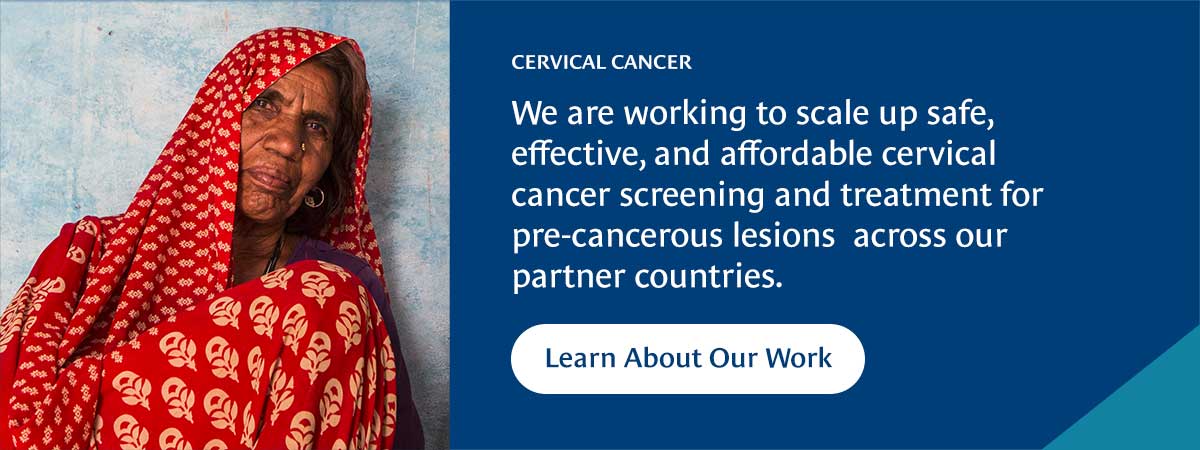CHAI has published a paper in BMJ that assesses the use of human papillomavirus (HPV) testing across five countries in Africa, where HPV testing was delivered through public health facilities.
Each year, women in low-and middle-income countries (LMICs) account for 90 percent of global deaths from cervical cancer. However, early screening to detect and treat pre-cancerous cells can prevent deaths from cervical cancer. By providing access to affordable screening, CHAI’s programs, funded by Unitaid, are supporting governments in LMICs to give more women an equal chance to live healthy and fulfilled lives.
Cervical cancer screening in LMICs has historically been delivered through an examination of the cervix, often using the visual inspection with acetic acid (VIA) method – a simple and inexpensive test that can be delivered by health workers with basic training. The results are almost immediate, with women screening positive often receiving treatment the same day – however, these tests are invasive, and can be unreliable.
In 2021, the World Health Organization (WHO) released new screening guidelines, urging programs to transition toward human papillomavirus (HPV) testing, a cost-effective, highly sensitive screening method. HPV nucleic acid amplification tests (NAATs) look for the presence of human papillomavirus, from either a clinician or patient-collected sample.
Last year, CHAI implemented a study in partnership with five sub-Saharan African countries (Malawi, Nigeria, Senegal, Uganda, and Zimbabwe) to assess the use of HPV testing in LMICs. The study revealed a few key learnings:
HPV testing enables self-sampling – breaking barriers to cervical cancer screening
While VIA requires a health worker to apply a solution and inspect the cervix, HPV testing enables women to collect their own sample without the need for a cervical exam. The study found self-collected sampling to be feasible and highly acceptable to women in these areas.
Importantly, we discovered most women preferred to self-sample, citing privacy as a key advantage. Most women found the self-sampling procedure easy to perform, with all women surveyed in Malawi reporting that they would recommend it. However, in Senegal, most women, particularly in more rural areas, preferred to have a trained clinician collect their sample, , preferring to trust their expertise.
HPV testing offers a cost-effective approach to cervical cancer screening
The analysis underlying the updated WHO screening guidelines shows that HPV testing is a cost-effective approach to screening, allowing greater intervals between screenings. Across the five countries, the average cost per test was just under US$12, with the least expensive test costing US$9. Leveraging global pricing deals and projected testing demand will allow programs to further minimize these costs.
HPV testing is feasible – but further work is required to ensure women receive their results
The most difficult task reported by healthcare workers during the study was returning HPV-positive results to patients: the study found only 72 percent of HPV-positive patients received their results.
Regardless of testing model, including both near-point-of-care and centralized models, we observed a significant drop-off in women receiving HPV results and returning for triage and treatment. As same-day results were often unable to reach patients, revised laboratory workflows and result return procedures were introduced to improve results return. In Senegal, healthcare workers scheduled appointments for the women to receive results the following day, while in Uganda stickers were added to patient files as a reminder to return results to patients.
These challenges highlight the need for additional investment and infrastructure to eliminate the barriers to returning test results to women, such as proactive community outreach to patients and reminders in patient files.
Our study confirmed HPV testing is a highly acceptable, feasible and promising model to deliver cervical cancer screening in sub-Saharan Africa. Over the course of the study, over 15,000 women were tested, with almost a third (32 percent) of those receiving valid results testing HPV positive. Adopting this model of care could, therefore, help accelerate global efforts to eliminate deaths from cervical cancer. These findings also highlight the need for further action to ensure test results are returned to women efficiently and that screen-positive women receive appropriate treatment as these programs are rolled out across the continent and beyond.






